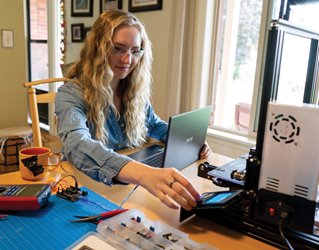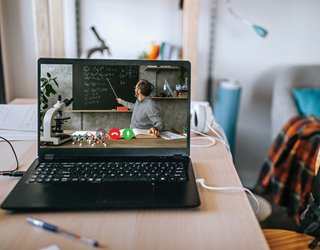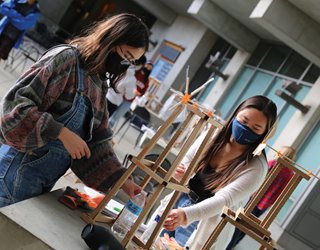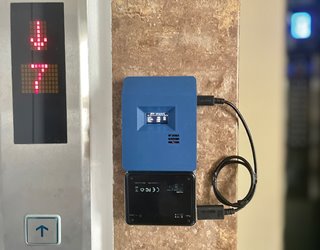Universities Look to Re-engineer Education
Universities Look to Re-engineer Education
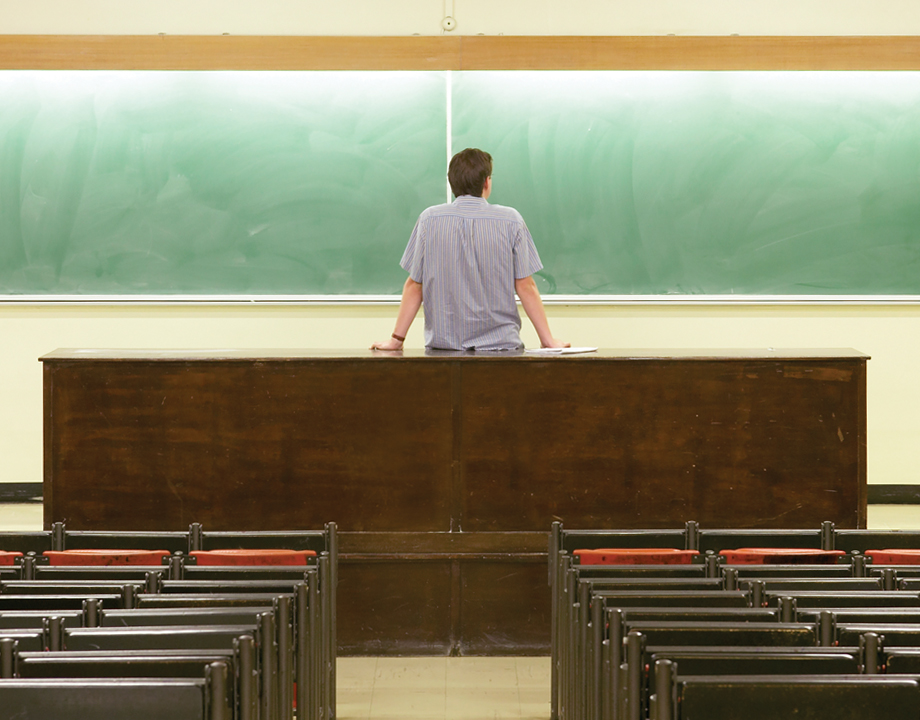

As engineering schools begin to restart in-person classes, they are looking at which new methods of digital instruction they should keep.
In the fall of 2020, the seniors at Columbia University’s Fu Foundation School of Engineering and Applied Science started receiving cardboard boxes in the mail. This was during the start of the third wave of the COVID-19 pandemic in the United States and for many people, home delivery had replaced in-store shopping, but these boxes weren’t filled with groceries or cloth masks. In fact, the students hadn’t ordered them; the school had.
These were “capstone kits.” The engineering school sent out sets of soldering irons, 3D printers, electronic components, even fans to vent away noxious fumes. The intention was that if students couldn’t make it into the lab to design and build the mechanism or product that would serve as their graduation project, the kits would enable them to perform that work from home. In the fall of 2020, all undergraduate courses at Columbia engineering were taught remotely and a quarter of graduate ones used a hybrid model, so all students taking a laboratory class received similar kits.
Faculty members initially thought of the kits as a stop-gap measure, a best possible substitute for the well-stocked university engineering lab. Soon, however, they realized that the kits did much more than bridge students to their diplomas or advance them to the next year. Having cool toys to play with at home whenever they felt like it gave students more time to experiment. They could let their imagination run wild and they didn’t need to be afraid of making mistakes.
“We found that having 3D printers at home really unleashed their creativity because they could print multiple things and experiment with multiple designs,” said Jeffrey Kysar, chair of the department of mechanical engineering.
Today, a personal computer is standard equipment for virtually every college student, no matter the major. Could 3D printers someday become the norm, too?
“It may be beneficial for students taking a specific course—when it’s best to experiment freely,” Kysar said, adding that Columbia hasn’t moved in that direction yet.
Listen to This: Podcast: How to Reinvigorate STEM Education Post-COVID-19
Columbia Engineering is not the only school that’s reconsidering its pre-pandemic modus operandi. Over the past 18 months, colleges of engineering across the country revamped how they deliver lectures, run labs, administer tests, and even attract students to come to their school. These changes to long-standing norms were initially adopted as temporary, emergency measures, but faculty, administrators, and students found that some of them were improvements.
During the height of the pandemic, people talked about certain accommodations to public health as “the new normal.” As the next academic year is set to begin this month, school administrators have had to assess the lessons from COVID-19 to see what parts of the new normal should become simply normal.
The large lecture class is a staple of first-year college life. The lecture halls for such courses must be large enough to accommodate several hundred students at the same time, and this led to problems: Professors had to shout or speak into a microphone, while students sitting up in the rafters could have trouble following along as complex equations were scrawled on distant white boards.
Even if other classes were conducted in person during the pandemic, large gatherings like that would be perilous. Instead, professors recorded their lectures so that students could watch them remotely. With many international and out-of-state students living at home, asynchronous learning meant the lectures were being watched all hours of the day and night. The class schedule accommodated the students, rather than the students organizing their lives according to the schedule.
The convenience didn’t end there. The new setup gave every student a front-row seat. And it enabled them to replay full lectures or just the particularly tricky parts they didn’t understand at first. Even smaller classes benefited from the replay feature.
“Some students really appreciate being able to re-watch the lecture where they don’t have to furiously take notes,” said Jelena Kovačević, dean of New York University Tandon School of Engineering.
Recorded lectures don’t allow for real-time student-professor interaction, but other classes were conducted live via streaming platforms such as Zoom, and some of the feature of those applications enabled new forms of class participation. The chat function, for instance, emboldened students who might be too shy to raise a hand in the middle of a 400-seat auditorium or yell down from the bleachers.
“Some students are intimidated to ask questions in a large room,” said Joanna Millunchick, associate dean for undergraduate education at the University of Michigan College of Engineering in Ann Arbor. In the chat, no one stares at you.
Moving professors’ office hours from rooms to Zooms was another newfound convenience.
“Some faculty members who used to have office hours during the day, when it wasn’t necessarily convenient for students who had classes, now have office hours six to eight in the evening because they don’t have to commute,” Kovačević said.
That was particular useful for students in different time zones. “I had students taking my course from China and California, so with online office hours I could talk to them at 7 p.m.,” said Marisol Koslowski, professor of mechanical engineering at Purdue University in West Lafayette, Ind. “I never did it before, but I’m going to keep it that way now.”
More on Education: COVID-19 Transforms Life on Engineering College Campuses
Remote office hours are a boon even for students on campus, since they don’t have to wait in line outside the professor’s office, Millunchick added. Other things proved more convenient on Zoom, too—such as discussing financial aid via the computer rather than traveling to the administration building on other side of campus.
At the crowded campus of the University of California, San Diego, having fewer people freed up not only rooms but also parking spaces, said infectious disease physician Robert “Chip” Schooley, who is in charge of the Return to Learn program at the UCSD. “We learned that many things we do on campus don’t have to be done on campus,” he said.
Another indispensable custom of college education that became impossible during the worst of the pandemic was the traditional final exam. “The high-stake closed-book exams, which are a right of passage, were very difficult to do,” Millunchick said, “so it made us think about what we really want to assess.” The conversations that started during the initial scramble in the spring of 2020 have continued more deliberatively since and have led to a surprising conclusion: “A lot of people think we can do something better,” Millunchick said.
For instance, the faculty at the Massachusetts Institute of Technology has decided to forgo some high-stake exams. “We worked to shift to many smaller formative assessments, rather than just having one big exam,” said Ian Waitz, vice chancellor for undergraduate and graduate education at MIT. “That’s regarded as a better education practice. It’s softer—it’s not about the curriculum structure, but rather about personal and human interaction.”
At the University of California, San Diego, remote learning spearheaded more personable assessments than ever before: oral exams. Professors initially gave oral exams over Zoom with the goal of maintaining academic integrity in remote classes, but they quickly discovered advantages over traditional written tests. Students learned to articulate their analytical work clearly and formed better bonds with their instructors.
Editor’s Choice: Finding Common Ground Across Generations
“At large institutions like UC San Diego some students never ask questions during a lecture or attend office hours,” explained Nate Delson, teaching professor at UCSD’s department of mechanical and aerospace engineering. “The oral exam gives them 15 minutes where they have one-on-one time with an instructor or a teaching assistant. We hope to continue this after COVID.”
Other schools are tapping into digital technology to improve the traditional written exam. The University of Michigan invested in an online version of closed book exams, in which custom-made software presents each test taker with individualized, randomly generated problems. That works particularly well for a circuits class where students must solve how various circuits would behave. “The software would generate a different circuit for every student, with a different battery, voltage, and the number of resistors,” Millunchick said.
Not every course can be conducted remotely; some still require students to physically experience things—such as SolidWorks or AutoCAD classes in which students have to learn to produce two-dimensional drawings of three-dimensional objects. Typically, professors would bring various three-dimensional parts to class and pass them around for students to examine and then draw.
“It is a practiced skill—to learn to look at something in 3D and imagine it in 2D,” Columbia’s Kysar said. It requires physically holding the parts. The Columbia engineering school had been considering employing virtual reality headsets to provide on-campus and off-campus students with the same experience, but that hasn’t gotten past the discussion phase.
Indeed, for all the talk of Zoom and VR as the possible future of education, every engineering faculty member interviewed for this story stressed the importance of in-person, on-campus learning. There is no good substitute for the peer-to-peer learning that happens in dorms, dining halls, maker spaces—or even large auditoriums.
Taking on COVID-19: Finding a Way Forward After the Pandemic
“The advantage of having a large lecture hall is that’s how we make friends and research colleagues—when we are randomly meeting people and joining clubs,” Kysar said. That serendipitous randomness—which is key to networking, finding project partners, and tapping people to brainstorm ideas with—does not happen virtually. “We found that serendipity is much harder electronically.”
With vaccines now widely available in the United States, the expectation for American universities is that they will operate as close as possible to the pre-pandemic reality. “The goal is to be as close to normal in September as possible,” Kysar said, “but with the understanding that many circumstances are beyond our control.” Should the emerging virus variants cause visa delays or travel hiccups, schools plan to ramp up remote or hybrid learning and adjust assessments.
With full semesters of on-campus life lost to COVID-19, some engineering professors began to worry that low spirits, pandemic pressures, and travel issues might discourage students from pursing their degree altogether.
“We were brainstorming—How do we make sure that we attract people, that they would come to our school?” Kovačević recalled.
NYU’s Tandon School of Engineering already had a robust online learning program, but the faculty wanted to give students additional incentives. In summer of 2020, ahead of the typical fall start date, the school offered master-level classes for free as a form of financial aid and a career service boot camp to let students imagine their future. “We called it a jumpstart experience,” Kovačević said.
Then the school did something even more exciting. They announced a Tandon Made Challenge, in which both undergraduate and graduate students would pitch solutions to real-life problems that medical workers at the NYU Langone Hospital needed to solve. Those whose ideas were picked received $5,000 to implement them.
The winning undergraduate team forged a kit that allowed elevator passengers to choose the floor without touching a button. The winning graduate team devised a flexible spring band that could wrap around the handles of shopping carts, rented bikes, and other things, reducing the spread of germs; it also came with a travel-size sanitizer. The Tandon Made Challenge proved so stimulating for students’ creativity and so beneficial overall, that it remains part of the operation, Kovačević said. “We’re keeping it. And when we can, we will do it in person.”
Creative problem solving is the holy grail of the engineering realm. Engineering minds naturally seek solutions and optimization—whether mechanical, electrical, or organizational. Therefore, the schools’ mission is not only teaching students the nuts and bolts of their profession but also to engender—or perhaps to engineer—such creativity in them, in part by creating the new learning realm.
“It will take a little bit of time to see what this new normal is going to be,” Kovačević said. “But I think this new normal will be better. It will be a positive step forward.”
Lina Zeldovich is a science and technology writer based in Woodside, N.Y.
These were “capstone kits.” The engineering school sent out sets of soldering irons, 3D printers, electronic components, even fans to vent away noxious fumes. The intention was that if students couldn’t make it into the lab to design and build the mechanism or product that would serve as their graduation project, the kits would enable them to perform that work from home. In the fall of 2020, all undergraduate courses at Columbia engineering were taught remotely and a quarter of graduate ones used a hybrid model, so all students taking a laboratory class received similar kits.
Faculty members initially thought of the kits as a stop-gap measure, a best possible substitute for the well-stocked university engineering lab. Soon, however, they realized that the kits did much more than bridge students to their diplomas or advance them to the next year. Having cool toys to play with at home whenever they felt like it gave students more time to experiment. They could let their imagination run wild and they didn’t need to be afraid of making mistakes.
“We found that having 3D printers at home really unleashed their creativity because they could print multiple things and experiment with multiple designs,” said Jeffrey Kysar, chair of the department of mechanical engineering.
Today, a personal computer is standard equipment for virtually every college student, no matter the major. Could 3D printers someday become the norm, too?
“It may be beneficial for students taking a specific course—when it’s best to experiment freely,” Kysar said, adding that Columbia hasn’t moved in that direction yet.
Listen to This: Podcast: How to Reinvigorate STEM Education Post-COVID-19
Columbia Engineering is not the only school that’s reconsidering its pre-pandemic modus operandi. Over the past 18 months, colleges of engineering across the country revamped how they deliver lectures, run labs, administer tests, and even attract students to come to their school. These changes to long-standing norms were initially adopted as temporary, emergency measures, but faculty, administrators, and students found that some of them were improvements.
During the height of the pandemic, people talked about certain accommodations to public health as “the new normal.” As the next academic year is set to begin this month, school administrators have had to assess the lessons from COVID-19 to see what parts of the new normal should become simply normal.
Remote Viewing
The large lecture class is a staple of first-year college life. The lecture halls for such courses must be large enough to accommodate several hundred students at the same time, and this led to problems: Professors had to shout or speak into a microphone, while students sitting up in the rafters could have trouble following along as complex equations were scrawled on distant white boards.
Even if other classes were conducted in person during the pandemic, large gatherings like that would be perilous. Instead, professors recorded their lectures so that students could watch them remotely. With many international and out-of-state students living at home, asynchronous learning meant the lectures were being watched all hours of the day and night. The class schedule accommodated the students, rather than the students organizing their lives according to the schedule.
The convenience didn’t end there. The new setup gave every student a front-row seat. And it enabled them to replay full lectures or just the particularly tricky parts they didn’t understand at first. Even smaller classes benefited from the replay feature.
“Some students really appreciate being able to re-watch the lecture where they don’t have to furiously take notes,” said Jelena Kovačević, dean of New York University Tandon School of Engineering.
Recorded lectures don’t allow for real-time student-professor interaction, but other classes were conducted live via streaming platforms such as Zoom, and some of the feature of those applications enabled new forms of class participation. The chat function, for instance, emboldened students who might be too shy to raise a hand in the middle of a 400-seat auditorium or yell down from the bleachers.
“Some students are intimidated to ask questions in a large room,” said Joanna Millunchick, associate dean for undergraduate education at the University of Michigan College of Engineering in Ann Arbor. In the chat, no one stares at you.
Moving professors’ office hours from rooms to Zooms was another newfound convenience.
“Some faculty members who used to have office hours during the day, when it wasn’t necessarily convenient for students who had classes, now have office hours six to eight in the evening because they don’t have to commute,” Kovačević said.
That was particular useful for students in different time zones. “I had students taking my course from China and California, so with online office hours I could talk to them at 7 p.m.,” said Marisol Koslowski, professor of mechanical engineering at Purdue University in West Lafayette, Ind. “I never did it before, but I’m going to keep it that way now.”
More on Education: COVID-19 Transforms Life on Engineering College Campuses
Remote office hours are a boon even for students on campus, since they don’t have to wait in line outside the professor’s office, Millunchick added. Other things proved more convenient on Zoom, too—such as discussing financial aid via the computer rather than traveling to the administration building on other side of campus.
At the crowded campus of the University of California, San Diego, having fewer people freed up not only rooms but also parking spaces, said infectious disease physician Robert “Chip” Schooley, who is in charge of the Return to Learn program at the UCSD. “We learned that many things we do on campus don’t have to be done on campus,” he said.
Examining Exams
Another indispensable custom of college education that became impossible during the worst of the pandemic was the traditional final exam. “The high-stake closed-book exams, which are a right of passage, were very difficult to do,” Millunchick said, “so it made us think about what we really want to assess.” The conversations that started during the initial scramble in the spring of 2020 have continued more deliberatively since and have led to a surprising conclusion: “A lot of people think we can do something better,” Millunchick said.
For instance, the faculty at the Massachusetts Institute of Technology has decided to forgo some high-stake exams. “We worked to shift to many smaller formative assessments, rather than just having one big exam,” said Ian Waitz, vice chancellor for undergraduate and graduate education at MIT. “That’s regarded as a better education practice. It’s softer—it’s not about the curriculum structure, but rather about personal and human interaction.”
At the University of California, San Diego, remote learning spearheaded more personable assessments than ever before: oral exams. Professors initially gave oral exams over Zoom with the goal of maintaining academic integrity in remote classes, but they quickly discovered advantages over traditional written tests. Students learned to articulate their analytical work clearly and formed better bonds with their instructors.
Editor’s Choice: Finding Common Ground Across Generations
“At large institutions like UC San Diego some students never ask questions during a lecture or attend office hours,” explained Nate Delson, teaching professor at UCSD’s department of mechanical and aerospace engineering. “The oral exam gives them 15 minutes where they have one-on-one time with an instructor or a teaching assistant. We hope to continue this after COVID.”
Other schools are tapping into digital technology to improve the traditional written exam. The University of Michigan invested in an online version of closed book exams, in which custom-made software presents each test taker with individualized, randomly generated problems. That works particularly well for a circuits class where students must solve how various circuits would behave. “The software would generate a different circuit for every student, with a different battery, voltage, and the number of resistors,” Millunchick said.
Not every course can be conducted remotely; some still require students to physically experience things—such as SolidWorks or AutoCAD classes in which students have to learn to produce two-dimensional drawings of three-dimensional objects. Typically, professors would bring various three-dimensional parts to class and pass them around for students to examine and then draw.
“It is a practiced skill—to learn to look at something in 3D and imagine it in 2D,” Columbia’s Kysar said. It requires physically holding the parts. The Columbia engineering school had been considering employing virtual reality headsets to provide on-campus and off-campus students with the same experience, but that hasn’t gotten past the discussion phase.
Indeed, for all the talk of Zoom and VR as the possible future of education, every engineering faculty member interviewed for this story stressed the importance of in-person, on-campus learning. There is no good substitute for the peer-to-peer learning that happens in dorms, dining halls, maker spaces—or even large auditoriums.
Taking on COVID-19: Finding a Way Forward After the Pandemic
“The advantage of having a large lecture hall is that’s how we make friends and research colleagues—when we are randomly meeting people and joining clubs,” Kysar said. That serendipitous randomness—which is key to networking, finding project partners, and tapping people to brainstorm ideas with—does not happen virtually. “We found that serendipity is much harder electronically.”
With vaccines now widely available in the United States, the expectation for American universities is that they will operate as close as possible to the pre-pandemic reality. “The goal is to be as close to normal in September as possible,” Kysar said, “but with the understanding that many circumstances are beyond our control.” Should the emerging virus variants cause visa delays or travel hiccups, schools plan to ramp up remote or hybrid learning and adjust assessments.
Ongoing Challenge
With full semesters of on-campus life lost to COVID-19, some engineering professors began to worry that low spirits, pandemic pressures, and travel issues might discourage students from pursing their degree altogether.
“We were brainstorming—How do we make sure that we attract people, that they would come to our school?” Kovačević recalled.
NYU’s Tandon School of Engineering already had a robust online learning program, but the faculty wanted to give students additional incentives. In summer of 2020, ahead of the typical fall start date, the school offered master-level classes for free as a form of financial aid and a career service boot camp to let students imagine their future. “We called it a jumpstart experience,” Kovačević said.
Then the school did something even more exciting. They announced a Tandon Made Challenge, in which both undergraduate and graduate students would pitch solutions to real-life problems that medical workers at the NYU Langone Hospital needed to solve. Those whose ideas were picked received $5,000 to implement them.
The winning undergraduate team forged a kit that allowed elevator passengers to choose the floor without touching a button. The winning graduate team devised a flexible spring band that could wrap around the handles of shopping carts, rented bikes, and other things, reducing the spread of germs; it also came with a travel-size sanitizer. The Tandon Made Challenge proved so stimulating for students’ creativity and so beneficial overall, that it remains part of the operation, Kovačević said. “We’re keeping it. And when we can, we will do it in person.”
Creative problem solving is the holy grail of the engineering realm. Engineering minds naturally seek solutions and optimization—whether mechanical, electrical, or organizational. Therefore, the schools’ mission is not only teaching students the nuts and bolts of their profession but also to engender—or perhaps to engineer—such creativity in them, in part by creating the new learning realm.
“It will take a little bit of time to see what this new normal is going to be,” Kovačević said. “But I think this new normal will be better. It will be a positive step forward.”
Lina Zeldovich is a science and technology writer based in Woodside, N.Y.


